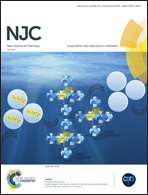Zn(ii)–nucleobase metal–organic nanofibers and nanoflowers: synthesis and photocatalytic application†
Abstract
The formation of hybrid metal–organic nanoscale materials using basic biological building blocks is highly appealing due to the rich functional group chemistry as well as green and benign environment offered by biomolecules which can significantly reduce the energy consumption in manufacturing processes. In this contribution, the spontaneous formation of crystalline hybrid organic–inorganic nanoscale materials such as nanofibers and nanoflowers through the supramolecular interaction of Zn2+ and unsubstituted nucleobases is reported. The interaction of cytosine and guanine with Zn2+ ions in alkaline medium led to the formation of metallogels with nanofibrous morphology. Surprisingly, the addition of Zn2+ ions to a solution containing a mixture of cytosine and guanine led to the formation of flower shaped crystalline coordination polymer particles. The catalytic activity of the three materials has been exploited for the photocatalytic degradation of environmental pollutant organic dyes such as methylene blue and methyl orange.



 Please wait while we load your content...
Please wait while we load your content...